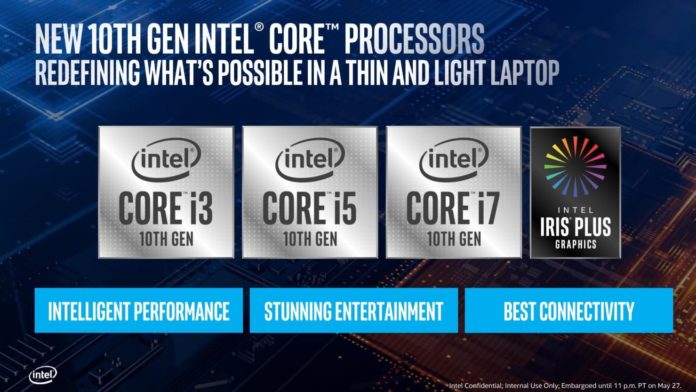Intel has been trying to transition to the 10nm node since forever now (read four+ years), and it seems like the chipmaker is finally back on track. Intel today unveiled the Ice Lake CPUs leveraging the 10nm node claiming an IPC gain of 18% (wait for it) compared to the Skylake architecture, released all the way back in 2015. This is the company’s highest inter-generation performance boost, and it comes via three main upgrades:
- Firstly, the more efficient 10nm process
- Secondly the use of Sunny Cove core architecture
- And lastly, the Gen11 UHD graphics

The mobile chips (Y and U) will be the first hit the market with TDPs of 9W, 15W,
Intel 10th Gen CPUs: Core Highlights
Moar Cache and Faster Memory
The 10th generation Intel Core CPUs will have up to four cores and eight threads and for the first time a rather generous low-level cache size (up to 8MB L2 and 48KB L1), with a max boost clock of 4.1GHz (these are mobile chips, after all, don’t complain). Like AMD’s Ryzen 3000 processors, the memory has also been fed a decent amount of steroids. The Ice Lake-U platform will support dual-channel LPDDR4 RAM as fast as 3733MHz, with a frequency of 3200MHz out of the box. This means a bandwidth gain of 60 GB/s, and will significantly boost certain workloads, explaining Intel’s peak gains of 30-40%.

Sunny Cove
Compared to the dated Skylake chips, Ice Lake offers a gain of up to 40%, with an average IPC gain of 18%. Most of this has been achieved via improvements to the memory controller, additional low-level cache and improved inference performance.
Related:
Thunderbolt 3
Thunderbolt support has been very limited in most notebooks, with the ones having them also stuck to just one side. Intel’s recent contributions to the standard have made it into a dual-sided controller, allowing up to two ports on either side of the laptop.
AI
Like NVIDIA, Intel is also giving AI-based technologies a lot of importance with a 2.5x improvement in inference performance thanks to DHBoost. Something called as Dynamic Tuning 2.0 has also been added. It uses machine learning to optimize the power consumption, by automatically reducing the power draw (without affecting the performance) whenever possible. Unlike most CPU governors or algorithms/curves, the 10th Gen Intel processors will track the user’s activity and accordingly develop a tailor-made power consumption profile that suits the requirement.

14nm PCH
Gen11 iGPU

Ice Lake’s Gen11 graphics are one of its most anticipated features. Developed by Raja Koduri’s team at the Visual Technologies Group, it can be seen as the first step in Intel’s foray into the world of actual graphics processors. The company demonstrated the capabilities of its new iGPU even before Computex started, claiming a lead over the Zen+ mobile processors (Ryzen 3700U) and its Vega processor. The GPU has been significantly expanded with an increase of more than 2x in the executing units, from 24 to 64 in ICL-U. This allows the chip to achieve 1TFLOPs of FP32 performance and twice the FP16 compute performance.
Intel Shares Futuristic Graphics Card Designs Expected by 2035

The Gen11 iGPU is going to compete against NVIDIA’s MX series and AMD’s mobile Vega processors, and Intel seems to be paying a lot of attention to gamers. You’ve got Adaptive Sync support, in-game optimizations for popular titles as well as HDR3 and Dolby Vision. The Ice Lake CPUs will also allow hardware-accelerated
Conclusion
The other day AMD stole the IPC crown from Intel claiming that the new 7nm Zen 2 CPUs beat the existing Coffee Lake in both single threaded as well as multi-threaded workloads. If Intel’s benchmarks are anything to go by, it’s highly likely that Intel will be taking it back with Ice Lake, but that’ll probably come at a premium price. Furthermore, all of today’s comparisons were against the 4 year old Skylake architecture, and not a single one put the Coffee Lake and Ice lake chips side by side (aside from the iGPU), so it’ll be interesting to see how much the IPC has increased over the 14nm++ architectures. The CPU market is finally become highly competitive again after almost a decade. It’ll only get better from here.
Read more:



